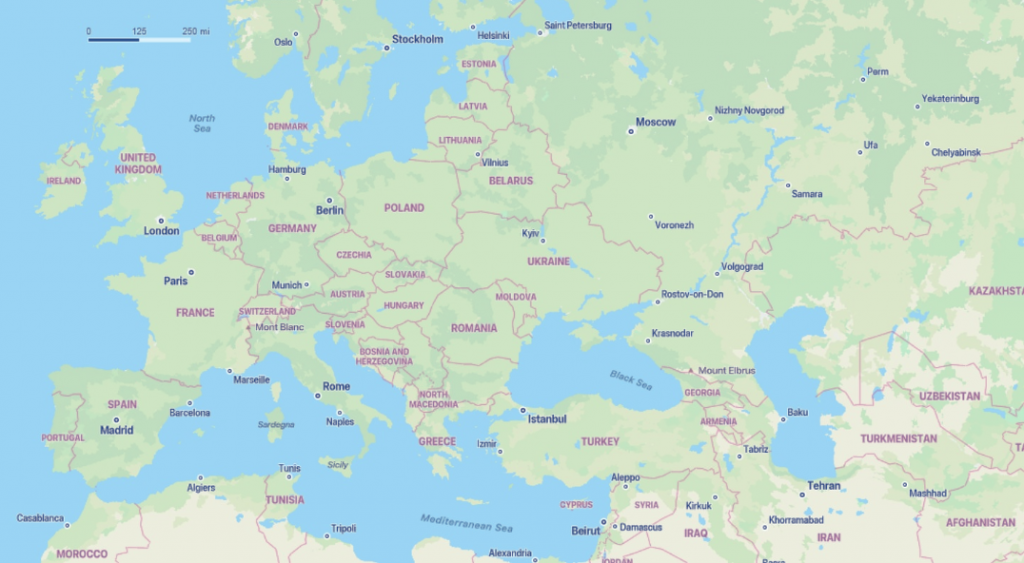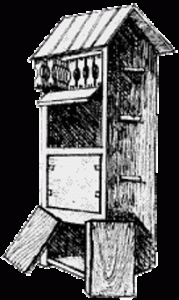By Vidya Rajan, Columnist, The Times
“History is all explained by geography.” Robert Penn Warren, novelist and poet (24 Apr 1905-1989)
In this article, I want to pay homage to Ukraine’s beekeepers and beekeeping in light of the many wars that have washed over this beleaguered land. With a land area only slightly smaller than the state of Texas, it lies at many junctions: between Europe and Asia, between “East” and “West”, provides trading access to perennial warm water ports in the Black Sea and thence to the Mediterranean Sea and the Atlantic Ocean. In this way, Ukraine is a lot like Turkey. It is a land that has strategic importance for purposes of trade, access, and conquest.

Figure 1: Political Map of Europe, North Africa, and Western Asia. Ukraine sits at the geographical crossroads between Europe and Asia, just above the Black Sea.
Ukraine was part of Scythia and a cross roads for migratory peoples during the Stone age, the Bronze age, and Indo-European migrations [1] and was “invented” as a country back in the 9th Century when it was called Kievan Rus. This country lasted only about 300 years until its disintegration in the 12th Century, after which much to-ing and fro-ing of its lands occurred between its warring and land-hungry neighbors. In 1917, after the Russian Revolution, the Bolsheviks invaded and replaced the government in Kyiv and subsumed Ukraine into the Union of Soviet and Socialist Republic (USSR). This situation lasted until 1991. Ukraine then became an independent country.
Beekeeping did not come to the Ukraine until the 1800s. The forested north and east of the country was home to feral bees and wild harvesting was the historical norm. In the winter, harvesters would look for signs of feral colonies such as dead bees at the base of a tree, or footprints of bears, who as we all know from the Winnie the Pooh stories, will do anything for honey. Once identified, harvesters would knock on the tree until a hollow space sounded. Then they would cut a “door” into the tree, taking honey from the torpid bees without the danger of being stung. When bees were flying, the flight of the bee would be tracked by honey-hunters. They would attach a would come back to the tree, identify the location of the bees They would also mark the tree doors with their “signs”, identifying it as their possession. These signs were collected by G. N. Anpilogov collected 16th and 17th Century symbols and published them in 1964 (Figure 2 in reference [2]). This marking was such standard practice that it was coded into law in the 11th Century, with bragging rights accompanying – apparently seven chapters of are devoted to beekeeping, more than those for any other profession. As time went on, the hunters started cutting the hollow bee-trees out and transporting them back to apiaries which consisted of bee logs placed in tiers inside a wattle fence with a thatched roof with surrounding little garden or orchard. Sometimes little sticks would be introduced into the hive to encourage the building of comb which could later be withdrawn, and the honey harvested.
The father of modern Ukrainian beekeeping is Petro Prokopovych (1775-1850). He was a decorated Soldier who was charmed by bees flitting around his brother’s garden, and devoted the rest of his life to understanding bees. Using the same principle of the sticks being introduced into the hive, Prokopovych pioneered a three-story hive separated by movable dividers. The bottom two tiers was where the bees build comb as they wished. The top tier contained movable frames with the correct spacing introduced such that recovering material was easy. Significantly, Prokopovych’s hives show he had an understanding of “bee space”. He started beekeeping in 1800, and by 1808 had 550 hives and by 1855, 2582 hives. In 1828, he began a beekeeping school in 1828 which lasted over 50 years. He had wanted to publish his detailed notes, and even bought a printing press for the purpose, but apparently was not permitted to print; it is not clear who was obstructing him from disseminating his discoveries in print. Still, he wrote over 50 articles for Russian beekeeping journals and, in 1841, he described his 1814 design for his hive which was picked up by Jan Dizeridon from Poland and August von Berlepsch from Germany, who further developed the idea of moveable frames. Pertinently, several of these European beekeepers, including Francois Huber in 1789, appear to have developed the idea of moveable frames independently. Over 10,000 of Prokopovych-designed hives were built, making it a commercial success.

Figure 2: Petro Prokopovych’s hive. Three levels of hive bodies with access doors at every level. The top level contains fixed frames. Reproduced from http://beekeeping.com.ua/html_en/prokopovych_en.html under Fair Use copyright law.
 The explosion of interest due to Prokopovych’s classes and the uptake of beekeeping across the agricultural nation made Ukraine a large producer, but most of the hives were rural. Although each Ukrainian is reported to eat a kilogram of honey each year on average, the collapse of the Soviet Union and the economic implosion dropped the production of honey from 1,000 tons in 2004. However, by 2016, production was up – to 57,000 tons![3] 33,000,000 lbs (16,500 tons) of honey made its way to the United States in 2015.
The explosion of interest due to Prokopovych’s classes and the uptake of beekeeping across the agricultural nation made Ukraine a large producer, but most of the hives were rural. Although each Ukrainian is reported to eat a kilogram of honey each year on average, the collapse of the Soviet Union and the economic implosion dropped the production of honey from 1,000 tons in 2004. However, by 2016, production was up – to 57,000 tons![3] 33,000,000 lbs (16,500 tons) of honey made its way to the United States in 2015.
The Ukrainian Beekeepers Association has pleaded with the rest of the beekeeping community to boycott Apimondia in Russia later this year.[4] It seems like the world’s beekeeping community has taken note and has moved the meeting to Istanbul of Ukraine has previously seen civil wars, genocide, invasions, and horrors like the Holodomyr, a famine inflicted on the population by Stalin, which saw people lying dead in the streets from starvation. It has been tugged this way and that by circumstance. It is not clear how the bees and beekeepers are faring in this war, but it is really astonishing to reflect on the will of a people who have endured everything history has thrown at them, and kept on going.
In that way, Ukrainians are a lot like honeybees.
NOTE: The opinions presented in this article are my own, and not in any way endorsed by the Chester County Beekeepers Association or the Pennsylvania State Beekeepers Association.
[1]. History of Ukraine. https://en.wikipedia.org/wiki/History_of_Ukraine. Accessed on April 23, 2022
[2]. Jones, R. (2013). A short history of beekeeping in the Ukraine. Bee World, 90(1), 12-14.
[3]. https://www.beeculture.com/ukraine-honey-exports/
[4]. https://www.beeculture.com/brotherhood-of-ukrainian-beekeepers/




